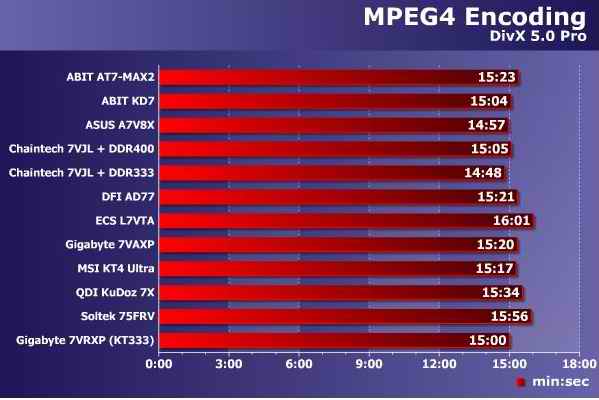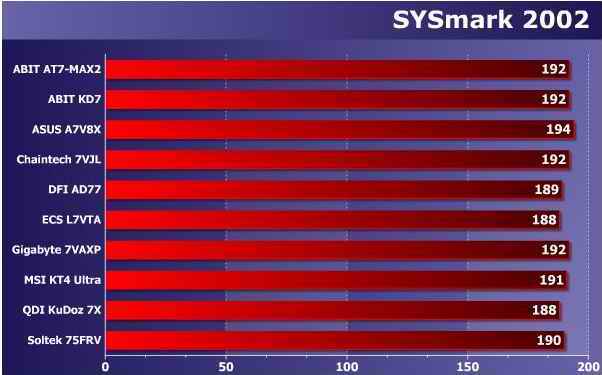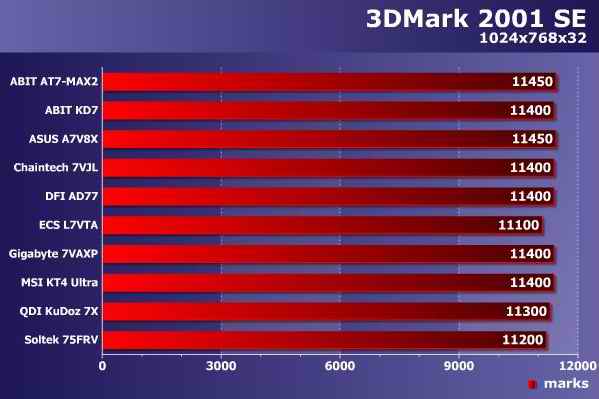TestingComponents tested:
Software:
|
| Board | Abit AT7-MAX2 | Abit KD7 RAID | ASUS A7V8X | Chaintech 7VJL Deluxe | DFI AD77 Infinity | Elitegroup L7VTA | Gigabyte 7VAXP | MSI KT4 Ultra | QDI KuDoz 7X | Soltek 75FRV |
| Chipset | VIA KT400 (KT400 + VT8235) | |||||||||
| Processors | Socket 462, AMD Duron, AMD Athlon, AMD Athlon XP | |||||||||
| Memory slots | 4 DDR | 4 DDR | 3 DDR | 4 DDR | 4 DDR | 3 DDR | 3 DDR | 3 DDR | 3 DDR | 3 DDR |
| Extensions | AGP/ 5 PCI | AGP/ 6 PCI | AGP/ 6 PCI | AGP/ 6 PCI | AGP/ 5 PCI/ CNR | AGP/ 5 PCI/ CNR | AGP/ 5 PCI | AGP/ 6 PCI | AGP/ 6 PCI/ CNR | AGP/ 5 PCI |
| Input/Output | 2 PS/2, 3 IEEE 1394 | 1 FDD, 2 COM, 1 LPT, 2 PS/2 | 1 FDD, 2 COM, 1 LPT, 2 PS/2, 2 IEEE 1394 | 1 FDD, 2 COM, 1 LPT, 2 PS/2 | 1 FDD, 2 COM, 1 LPT, 2 PS/2, 3 IEEE 1394 | 1 FDD, 2 COM, 1 LPT, 2 PS/2, 2 IEEE 1394 | 1 FDD, 2 COM, 1 LPT, 2 PS/2, 3 IEEE 1394 | 1 FDD, 2 COM, 1 LPT, 2 PS/2 | 1 FDD, 2 COM, 1 LPT, 2 PS/2 | 1 FDD, 2 COM, 1 LPT, 2 PS/2 |
| USB | 6 USB 2.0 + 2x2 USB 2.0 | 2 USB 2.0 + 2x2 USB 2.0 | 4 USB 2.0 + 1x2 USB 2.0 | 2 USB 2.0 + 2x2 USB 2.0 | 4 USB 2.0 + 1x2 USB 2.0 | 4 USB 2.0 + 1x2 USB 2.0 | 2 USB 2.0 + 2x2 USB 2.0 | 4 USB 2.0 + 1x2 USB 2.0 | 2 USB 2.0 + 2x2 USB 2.0 | 2 USB 2.0 + 2x2 USB 2.0 |
| IDE (Integrated) | ATA133 | |||||||||
| External IDE | HighPoint HPT374+ Marvell 88i8030 | HighPoint HPT372 | Promise PDC20376 | — | HighPoint HPT371+ Marvell 88i8030 | Promise PDC20265R | Promise PDC20276 | — | — | — |
| Sound | AC’97-кодек, Avance Logic ALC650 | AC’97-кодек, Avance Logic ALC650 | AC’97-кодек, Avance Logic ALC650 | PCI Audio, C-Media CMI8738/PCI-6ch-LX | AC’97-кодек, Avance Logic ALC650 | AC’97-кодек, VIA VT1612A | AC’97-кодек, Avance Logic ALC650 | PCI Audio, C-Media CMI8738/PCI-6ch-MX | AC’97-кодек, VIA VT1616 | AC’97-кодек, Avance Logic ALC650 |
| Network Controller | 10BaseT/ 100BaseTX | 10BaseT/ 100BaseTX | Broadcom BCM5702CKFB | 10BaseT/ 100BaseTX | 10BaseT/ 100BaseTX | 10BaseT/ 100BaseTX | Realtek 8100BL | — | VIA VT6105 LOM | — |
| Cards Connection | — | — | — | — | — | — | SMC, MS | — | SMC | SMC |
| I/O-controller | Winbond W83697HF | Winbond W83697HF | ITE IT8703F-A | ITE IT8705F | Winbond W83697HF | ITE IT8705F | ITE IT8705F | Winbond W83697HF | ITE IT8705F | ITE IT8705F |
| BIOS | 2 Мбит Phoenix AwardBIOS v6.00PG | 2 Мбит Phoenix AwardBIOS v6.00PG | 4 Мбит Award BIOS v6.00 | 2 Мбит Phoenix AwardBIOS v6.00PG | 2 Мбит Phoenix AwardBIOS v6.00PG | 2 Мбит Phoenix AwardBIOS v6.00PG | 2 Мбит Award BIOS v6.00PG | 2 Мбит AMI BIOS v3.31a | 2 Мбит Phoenix AwardBIOS v6.00PG | 2 Мбит AMI BIOS v3.31a |
| Form-Factor | ATX, 30,5x24,5 cm | ATX, 30,5x24,5 cm | ATX, 30,5x24,5 cm | ATX, 30,5x24,5 cm | ATX, 30,5x24,5 cm | ATX, 30,5x24,5 cm | ATX, 30,5x23,5 cm | ATX, 30,5x23 см | ATX, 30,5x24 cm | ATX, 30,5x22,5 cm |
| Distributable | good | usual | good | good | good | good | good | good | no data | usual |
| Overclocking | great | great | great | great | great | great | great | great | great | great |
Testing Results
It was decided to take VIA KT333 main
board... The fastest in the previous testing - Gigabyte 7VRXP as well as
DDR400 for VIA KT400 Main boards although this memory wasn't officially
certified. But still...All the systems showed the stability during the testing
and the results are for you below. (You need
Macromedia Flash 4 or higher to view the
tests) 
I placed these tests together because they actually fully load the system-memory combination - the main target of this testing for VIA KT400. If evolutional changes were made the results would have been completely different. So what have we seen: We saw the instability of DDR400 for VIA KT400 Main boards. In fact, Chaintech one with DDR333 showed the best results. At all there's a progress of 2-3% in results. Gigabyte came third after Chaintech and ASUS so this actually means that VIA KT400 brought nothing evolutional and I actually can't see any serious reason of going on with the testng
ASUS A7V8X is quite noticeable as it
was the only main board that showed better results than the one on VIA KT333
even with DDR400 installed. 
And SYSmark traditionally to show that
there's no big difference in the performances...If you buy the top main board
you will get a 3% advantage in editing the Internet content and working with
Office. Well, I still believe, you're not buying this for typing in MS Word. 
And, finally the results of
3D-Shooters, fastest @ 800x600x16, fps . This testing shows the productivity of video card - processor. ASUS and Chaintech are as usually in the lead while Soltek and Elitegroup take surprisingly low positions as they are outsiders again. All the main boards are all going well in this benchmark that is primarily for 3D Games productivity. ResumeSo the resume is actually quite clear. VIA KT400 are not worse than VIA KT333. I don't want to force you not to buy these main boards. All I want to say is that there is no point of buying DDR400 for VIA KT400 as they are not certified and are actually rare and provided with minimal timings at the moment. So high-quality DDR333 Modules can well provide the biggest needs of the main board. The advantage of VIA KT400 main boards is the VT8235 South Bridge (although you can find it in some KT333 boards as well). Anyway, VIA KT400 is not the worst solution at all. If deciding between VIA KT333 and VIA KT400 the productivity/price difference should be the main thing. About the models now: ASUS A7V8X and ABIT KD7-RAID, are the leaders.....well their lead is not looking so sure...but still. Some models surprised by a low performance. If Soltek 75FRV is only 3—4% lower than the middle group, Elitegroup L7VTA sometimes shows 7% that is not normal. I wouldn't offer it to you. Some other main boards are well packaged and grouped ( I mean different extensions and this stuff). The characteristics I placed is informational enough for you. Finally, the prices might help you to finally decide. But anyway: all this stuff is for AMD Athlon XP processors for 266 MHz FSB. But according to AMD new 333 MHz processors are to be released. These are not Hammers but with Barton core (512 KB of L2 Cache). So will VIA KT400 be upgraded (current version doesn't support the mode of 333 MHz FSB) and adapted for 333 MHz Front-Side Bus.
Thanks to iXBT.com for some help in
preparing the main boards characteristics
Posted on 24.11.2002 |